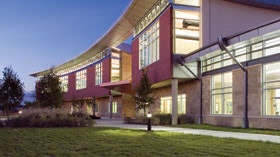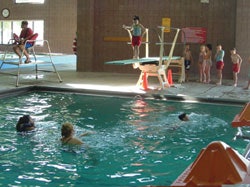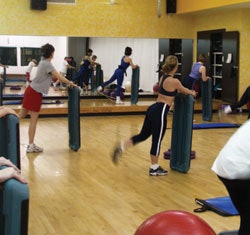Parks and rec professionals play a critical, yet critically nonpartisan, role in the success of referendums.

"We strongly believe that a referendum should not be a discovery process," says Martin, an associate at facility planning and program management consultancy Brailsford & Dunlavey. "Referendums should affirm support for a project. Prior to a referendum, we recommend market analysis, feasibility studies and other planning so the community can help plan a project that meets its needs. When you do go for your referendum, you want to know already what the outcome will be."
As a parks and recreation provider, achieving that kind of assuredness - especially given the recent political and economic turbulence that's been affecting much of the country - is no easy task. But experts across the board agree that it begins with a genuine interest in measuring the wants of the citizenry - finding out what parks and recreation facilities and amenities residents demand or desire from their government, as well as what they're willing to pay for them.
"For the voters, it comes down to a value judgment," says Ken Ballard, president and founding partner of recreation facility planning and operations consultancy Ballard*King & Associates. "You're talking about quality-of-life issues and the benefits of recreation. But those are going to be weighed against questions like, 'What's it going to cost me, both in tax dollars and potential user fees, to gain those benefits?' "
Those questions need answers early in the referendum process, meaning community involvement, needs assessment, and market and feasibility analyses all must be considered long before the ballot language is set. "There is often no real understanding of how much time this process takes," says Ballard. "We'll get calls from communities in spring or even late June that are trying to get a project passed in November, and they haven't even started with feasibility. That's too late. It's usually much better to delay a vote than it is to try and squeeze six months of work into three months. Your chances for success drop pretty dramatically when you're trying to force the process."
Ballard and Martin each say feasibility work - which is essentially a requirement in the private sector, certainly for any facility rivaling the size and scope of, say, a recreation center - should be done approximately nine months prior to the referendum. "That will help give you a clear message about what the project includes, why it includes those specific pieces, and how it's meeting the demands of the community," says Martin.
While nine months is preferred, the window for launching feasibility is approximately six months to a year prior to the vote. Wait too long, says Ballard, and you'll run out of time. Start too soon, he says, and a project can lose momentum or some of the numbers may become obsolete due to changing construction costs.
No matter when the referendum planning process begins, community involvement is crucial from the outset. "There has to be some initial buy-in from the public - through community meetings, focus groups, stakeholder meetings and surveys," says Ballard. "We're firm believers in having a kind of project task force or independent committee. It always takes that grassroots support to really position a project for success."
These groups tend to grow organically as citizens lead and take interest in a project, and the greater the variety of voter demographics represented, the more effective the group will be in horizontally communicating information about the project to the general public. "These efforts have to be community led," says Martin. "This should not be led by the government or a consulting firm, although those are definitely resources."
Similarly, if the bond package being formed or presented will include multiple projects, it may be well worth the effort to try to distribute the proposed new wealth to as many neighborhoods or geographical areas as possible within a given municipality.
"There certainly are a lot of special interest groups out there - soccer clubs, swim teams - and they can influence what goes into the bond package," says Robin Reeves, chief park planner for the Plano (Texas) Parks and Recreation Department. "But for the most part, we have made a conscious effort to include as many things as possible to make sure that our improvements are occurring throughout the city, that they're not weighted heavily toward a certain area."
Reeves also believes a nearly three-decades-old master-planning process was so successful and drew out so much civic responsibility from Plano residents that it has since made hitting voters up for parks and recreation capital a fairly smooth affair. "The city has had such a good comprehensive plan and the communities have bought into it," says Reeves, who in more than two decades in the parks and recreation department has seen the affluent Dallas suburb's population more than double.


The result is a certain amount of trust among voters. In 2005, despite being told it would raise their taxes, 73 percent of Plano residents supported a $58 million referendum for a new nature reserve, buying new parkland and improving athletic fields, among other initiatives. In that same year, voters also approved the construction of a $21 million recreation center, and another $5 million for renovation and expansion of yet another recreation center. All these proposals were reflective of the city's well-defined recreation blueprint, according to Reeves. "People who move to Plano can look at that comprehensive plan and see that, sure enough, the city has done what it said it was going to do," he says.
Voter confidence is also bolstered by an agency's track record of delivering high-quality facilities that have been built and operated in accordance with the terms laid out in the referendum that initially made the facilities possible.
In August, voters among the 6,500 residents of Delta, Colo., approved extending a ¾-cent sales tax that since 1993 has covered the debt service for the 55,000-square-foot Bill Heddles Recreation Center. The facility serves an approximately 40-mile radius in and around Delta, says the city's recreation division director, Wilma Erven. The ballot question asked residents to extend the sales tax, which was due to sunset in 2011, in order to fund some major upgrades - including replacing some HVAC components and sand filters for multiple pools - as well as some expansion. Needing just a simple majority to pass, the referendum garnered 71 percent of the vote.
"It passed by a huge margin - especially compared to what's happening to other towns in our area," says Erven. "Towns much bigger than ours have been trying to get recreation centers passed for a long time, and they haven't been able to."
While Erven attributes much of the voter support to the long hours spent campaigning by a community organization - Friends of the Rec Center - equally important has been the reputation of the facility among residents, and the department's reputation regarding fiduciary responsibilities.
"We were able to pass the referendum because people have really enjoyed the benefits," says Erven. "We're talking about upgrading HVAC, filters, mechanical systems. These are items that people can't even see; they're above the ceiling or in a back room. But I believe people have come to really appreciate the existing facility."
Plano's Reeves likewise says that developing a reputation for delivering a good product within the allotted budget can make voters less apprehensive the next time they're at the polls facing a request for parks and rec spending.
"We feel it's critical that whenever we get bond money, whatever we're doing with it, we're doing good," he says. "People will remember those facilities and say, 'That was well done; we like what we got, and we're ready to approve more.' Good facilities are one of the best advertisements you can have."
Naturally, not all voters have first-hand knowledge of, or even an interest in, the benefits provided by recreation facilities. And since laws in most jurisdictions strictly prevent the use of public money to fund informational campaigns that are in any way related to the advocacy of municipal projects, those campaigns are most often led by resident volunteers.
"You have to be very careful about what role you take," Ballard says. "Certainly you can provide basic information and some support for that campaign, but a lot of the legwork and the actual campaigning has to and should be done by that community group."
Often, too, there needs to be a private fundraising effort to run the informational campaign. "You could be talking about $10,000 to $20,000 just to start with ads and brochures," says Martin. "They might want to offer refreshments at a meeting, and those kinds of things can add up."
Common elements of an informational campaign include fliers and brochures, but Martin says those too often lack the kind of information that's truly going to engage and inspire voters. "You not only want to have the pretty pictures, project images and overall concepts, you need to be specific about what's going to be included in that building when it's finished," she says. "All the information you have - who will be allowed to use it and when, scheduling information, any partnerships that may be involved - use it."
Other effective campaign strategies may include placing ads in local papers, or even creating a short, strictly informational video that can be shown at public gatherings or on monitors at existing municipal facilities. Most effective of all, says Martin, are live question-and-answer sessions. "You can clearly present the project concept," she says. "It's about getting the right information out there so people aren't misinformed."
Ballard suggests that informational campaigners tend to spend too much effort trying to sway outspoken and influential opponents of capital projects. "You are always going to have people who are real champions of the project, and who see a direct benefit to them personally - they are the special interest groups - and then you have the strict anti-tax people and others who are vehemently opposed to it," says Ballard. "The key is reaching all those people in the middle. You want to spend more time getting out the vote than you do trying to convince people who are opposed to the project to support it. In most cases, you're not going to change their minds."
While strict anti-tax crowds may not be swayed by an informational campaign, those who oppose a project solely based on site selection sometimes can be. In Plano, voters citywide approved funding for a $21 million recreation center in 2005. City officials and residents knew in advance generally which neighborhood the center would serve. However, when it came time for site selection, nearby residents protested. "It's not that they didn't want the facility, they just didn't want it right in their neighborhood," says Reeves. Residents, citing the abundance of backyard pools in the immediate area, as well as the fact that most of the surrounding homeowners had private gym memberships, said "We're not going to use it, and we do not want everyone else in town coming to use it," explains Reeves.
With no other suitable sites nearby, the city then devoted time and energy to meeting with those opponents, for the purposes of both disseminating information and working to find amicable programming and design solutions. "We had many a meeting in that neighborhood. There was a point where we almost didn't build there because of the opposition," says Reeves. "But we at least gave them an opportunity to feel like they had some input - and we did incorporate a lot of that input about traffic issues and the site plan."
Residents eventually changed their views. The Tom Muehlenbeck Center was built, opened in 2007, and nearly 12,000 mostly neighborhood memberships were sold in the course of just three months. "What they realized is that there's a lot of difference between the pool in their backyard and a public pool," says Reeves. "We've now got water slides, swim lessons, water aerobics - people just didn't think about what a public pool could offer them."
Reeves believes inspiring confidence in voters doesn't require politicking or any other sort of manipulative tactics. "You just have to be able to talk factually about things and say, 'Here's the deal: If you want a rec center in this part of town and this is what you want it to be, this is what it's going to cost,' " he says. "We try to point out what positives we can, but in a very factual way. There certainly are a lot of benefits to parks and recreation that we can simply point out without actually urging people to vote 'yes.' "
































